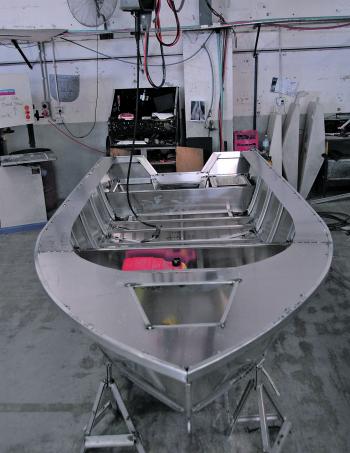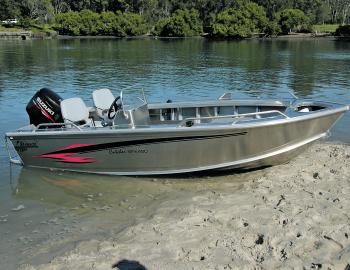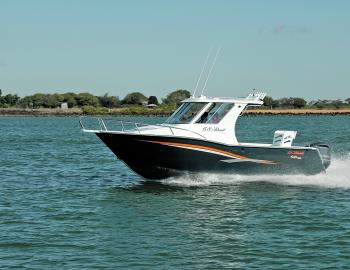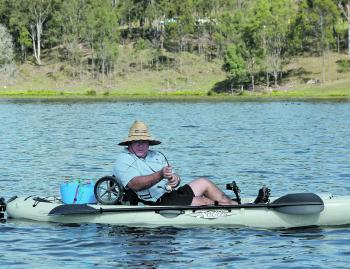In last month’s issue I covered a lot of ground in considering some of the more important factors that can influence the selection of the right fishing boat for a given fishing situation. Pretty obviously this is one mighty big topic given the differing fishing scenarios that exist and the fact that we use virtually everything from paddleboards to big ocean-going rigs to chase our fish!
Between those widely spaced parameters there is always just the right fishing boat for the job. It’s merely a matter of making the right selection from the get-go. If things are assessed correctly from the start, the chosen craft should be on the money when it comes to chasing those fish.
The trouble is that boats are about as plentiful as those sensational sunproof shirts we anglers like to wear. And just like the plethora of sun shirts in the tackle and water sports shops, there are just as many boats about with differing designs, attractively useful features (or otherwise) and standards of finish and fit out that can go from terrific to terrible.
In the sun shirt stakes some of us like really flashy ones with a trendy design, the maker’s logo prominent up front and maybe a fish or two being flashed on the back. A comparable boat might well show off so much bling it fairly shines on the darkest night, and why not? There are quite a few dollar’s worth of lights tucked under those gunwales!
Our bling boat naturally sports the best possible finish in gleaming glass or an awesome alloy paint job, as many bells and whistles as possible and enough fishing features onboard to warrant regular envious inspection. It’s not everyone’s boat, naturally, but guess what? The owner catches a lot of fish because the rig is perfect for his or her fishing requirements.
On the other side of the picture, the sun shirt is old, faded and perhaps a bit tatty. Close to being declared the next cockpit hand wipe in fact: but the nonchalant owner still wears it happily whether on the water or not.
The tatty sun shirt style of boat will likely be faded fibreglass or weather worn alloy with a few dings, dents and stains within and without. If it’s a small tinnie the seats might have seen some brief duty as cutting boards and it’s no surprise that the engine cowling is faded. Yet the boat seems to have a lot of large fish scales within its crusty sides, dried crab legs are tucked into the odd corner and the boat even smells like the sea at low tide. Again, the owner certainly knows how to score a feed of fish or crustaceans. And again that craft is not for all.
While boats might vary, the selection of a just-right rig often comes with one major decision. Do we go with glass or alloy?
Last month’s issues of freeboard, sea keeping ability, ride quality and fishing room are still very much in the mix, naturally, but in this piece we’ll look further into the pros and cons of both glass and aluminium products. This is not a glass versus alloy debate. It’s to show what they can offer a potential owner.
It’s not hard to comprehend the popularity of alloy boats. Versatility of design ensures that the buyer can usually find a rig within the proposed price range and intended purpose without too much expenditure of precious time or money.
Factors favouring alloy craft include less weight per metre of hull length and there’s the sweetener of reduced requirements for care around the ramps and rocks, especially with an unpainted hull. Beware of a painted hull touching one of those pontoons with yellow buffers, especially if said buffer is weathered. These things can scuff paint terribly, so keeping the hull from prolonged contact is wise.
All alloy craft still need some TLC with overall use and storage. Battery isolator switches are essential to keep power from leaking and causing electrolysis. A good clean after use also keeps paint in good condition. Avoid leaving tackle with little metal bits on the floor of the tinnie – again, because of electrolysis.
The greatest steps forward with alloy craft in the last decade would have to come down to overall design improvements thanks to today’s state-of-the-art stretch formed hulls and MIG and TIG welding techniques that offer strength and neatness of finish in spades. Enhanced second and third generation hull designs promote good riding characteristics and the old days of rough riding tinnies are well in the past.
Variation in available sizes is another factor to consider. It’s a fact that alloy craft range from 2.5m tenders (seen any 2.5m glass craft lately?) through to 7m+ ocean-going fish fighters that come bunk equipped, pack immense fuel supplies and ample freshwater and feature every comfort from refrigeration in the galley to hot showers and a marine toilet. In between these extremes are craft that meet every conceivable need from family fishing rigs to specialised finesse fishing outfits for true enthusiasts.
From sub 4m roof rack riders through to well powered plate alloy trailer rigs, the potential buyer is spoilt for choice.
Design diversity is a big plus with alloy craft. A manufacturer can offer the same basic hull (in, say, a sub 5m craft) with options for tiller steer, side or centre console with forward controls or, with as many or as few additional features as that craft’s price point allows. The same hull can be painted to perfection or left as bright alloy, yet either style could feature additional niceties such as a flat floor, rod holders, plumbed bait or catch wells, useful storage areas, an electric motor mounting point, auxiliary motor mount and even bimini shading.
Modern alloy craft are also built to last thanks to time-proven and well-engineered structural arrangements throughout that ensure the most basic alloy rig has guaranteed rigidity. Even the lightest hull, where side thickness might be as fine as 1.6mm will maintain total integrity in the toughest working conditions.
Cost overall is often where an alloy craft can leave some change in the pocket, compared to a glass rig of similar size and spec level. Reduced hull construction time along with designs that involve as little waste material as practical mean quicker turn over of product and value added production. Aluminium’s lighter weight also means that suitable outboard engines can be less powerful and therefore less costly for optimum results.
For trailer craft, which is the domain of most alloy rigs, a less involved trailer with lighter weight also sees many tinnies on the tow ball of the family sedan when it’s fishing time, with only the big plate alloy ocean goers requiring a big 4x4 to get them to the ramp.
Another matter for consideration must be repairs and modifications. If an alloy craft needs this sort of work, flatter surfaces are easy to work on. Cutting, welding, sanding, grinding and even painting are all feasible. Given that aluminium is such an easy material to work with and so many skilled welders are available, it’s not out of the question that a competent alloy welder might be located for repairs or other work even if you’re far from home.
On a glass craft modifications can involve far more. Firstly the right materials need to be on hand and, as the material needs to be applied or reworked in a state of flexibility, specific expertise is necessary. Moreover, colour matching of older or weathered surfaces can be tricky. In some cases the craft might need attention by the original manufacturer to bring things up to speed.
Alloy craft are deservedly popular given the advantages I’ve outlined. These factors should make selecting the right craft for the job easier, but let’s not overlook fibreglass either.
In next month’s issue I will outline what fibreglass boats offer the angler. From smallest to largest, there are quite a lot of things to consider, so don’t write glass rigs off just yet!
Reads: 4798
Modern alloy welding techniques offer rapid production, minimal waste and the assurance of a well-finished and sturdy end product for the angler.

Just like our fishing shirts, alloy craft come in all sizes and shapes. This well-built pontoon rig combines immense stability with ample fishing room.

Never think that only larger alloy craft come in plate construction: this little Mojo features 4mm plate all round.

Plain alloy dressed up with a decal show the versatility of this sort of rig.

SeaJay’s mighty 6.8 Pursuit is a big boat with big everything. If there is anything lacking in this great plate alloy it hasn’t been invented yet.


From kayaks to mighty offshore rigs, anglers align their choices with their needs to get the most from their fishing.




